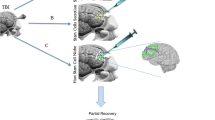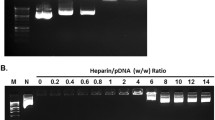Abstract
Viral vector gene delivery is a promising technique for the therapeutic administration of proteins to damaged tissue for the improvement of regeneration outcomes in various disease settings including brain and spinal cord injury, as well as autoimmune diseases. Though promising results have been demonstrated, limitations of viral vectors, including spread of the virus to distant sites, neutralization by the host immune system, and low transduction efficiencies have stimulated the investigation of biomaterials as gene delivery vehicles for improved protein expression at an injury site. Here, we show how Nfluorenylmethyloxycarbonyl (Fmoc) self-assembling peptide (SAP) hydrogels, designed for tissue-specific central nervous system (CNS) applications via incorporation of the laminin peptide sequence isoleucine–lysine–valine–alanine–valine (IKVAV), are effective as biocompatible, localized viral vector gene delivery vehicles in vivo. Through the addition of a C-terminal lysine (K) residue, we show that increased electrostatic interactions, provided by the additional amine side chain, allow effective immobilization of lentiviral vector particles, thereby limiting their activity exclusively to the site of injection and enabling focal gene delivery in vivo in a tissue-specific manner. When the C-terminal lysine was absent, no difference was observed between the number of transfected cells, the volume of tissue transfected, or the transfection efficiency with and without the Fmoc-SAP. Importantly, immobilization of the virus only affected transfection cell number and volume, with no impact observed on transfection efficiency. This hydrogel allows the sustained and targeted delivery of growth factors post injury. We have established Fmoc-SAPs as a versatile platform for enhanced biomaterial design for a range of tissue engineering applications.

Similar content being viewed by others
References
Jang, J.-H.; Schaffer, D. V.; Shea, L. D. Engineering biomaterial systems to enhance viral vector gene delivery. Mol. Ther. 2011, 19, 1407–1415.
Wang, K.; Hu, Q. D.; Zhu, W.; Zhao, M. M.; Ping, Y.; Tang, G. P. Structure-invertible nanoparticles for triggered co-delivery of nucleic acids and hydrophobic drugs for combination cancer therapy. Adv. Funct. Mater. 2015, 25, 3380–3392.
Allen, S. J.; Watson, J. J.; Shoemark, D. K.; Barua, N. U.; Patel, N. K. GDNF, NGF and BDNF as therapeutic options for neurodegeneration. Pharmacol. Ther. 2013, 138, 155–175.
Orive, G.; Anitua, E.; Pedraz, J. L.; Emerich, D. F. Biomaterials for promoting brain protection, repair and regeneration. Nat. Rev. Neurosci. 2009, 10, 682–692.
Horne, M. K.; Nisbet, D. R.; Forsythe, J. S.; Parish, C. L. Three-dimensional nanofibrous scaffolds incorporating immobilized BDNF promote proliferation and differentiation of cortical neural stem cells. Stem Cells Dev. 2010, 19, 843–852.
Levenberg, S.; Burdick, J. A.; Kraehenbuehl, T.; Langer, R. Neurotrophin-induced differentiation of human embryonic stem cells on three-dimensional polymeric scaffolds. Tissue Eng. 2005, 11, 506–512.
Kauhausen, J.; Thompson, L. H.; Parish, C. L. Cell intrinsic and extrinsic factors contribute to enhance neural circuit reconstruction following transplantation in Parkinsonian mice. J. Physiol. 2013, 591, 77–91.
Oliveira, S. L. B.; Pillat, M. M.; Cheffer, A.; Lameu, C.; Schwindt, T. T.; Ulrich, H. Functions of neurotrophins and growth factors in neurogenesis and brain repair. Cytomet. Part A 2013, 83A, 76–89.
Wang, T. Y.; Forsythe, J. S.; Nisbet, D. R.; Parish, C. L. Promoting engraftment of transplanted neural stem cells/progenitors using biofunctionalised electrospun scaffolds. Biomaterials 2012, 33, 9188–9197.
Alexi, T.; Borlongan, C. V.; Faull, R. L. M.; Williams, C. E.; Clark, R. G.; Gluckman, P. D.; Hughes, P. E. Neuroprotective strategies for basal ganglia degeneration: Parkinson’s and Huntington’s diseases. Prog. Neurobiol. 2000, 60, 409–470.
Choi-Lundberg, D. L.; Lin, Q.; Chang, Y.-N.; Chiang, Y. L.; Hay, C. M.; Mohajeri, H.; Davidson, B. L.; Bohn, M. C. Dopaminergic neurons protected from degeneration by GDNF gene therapy. Science 1997, 275, 838–841.
Géral, C.; Angelova, A.; Lesieur, S. From molecular to nanotechnology strategies for delivery of neurotrophins: Emphasis on brain-derived neurotrophic factor (BDNF). Pharmaceutics 2013, 5, 127–167.
Kotterman, M. A.; Schaffer, D. V. Engineering adenoassociated viruses for clinical gene therapy. Nat. Rev. Genet. 2014, 15, 445–451.
Björklund, A.; Kirik, D.; Rosenblad, C.; Georgievska, B.; Lundberg, C.; Mandel, R. J. Towards a neuroprotective gene therapy for Parkinson’s disease: Use of adenovirus, AAV and lentivirus vectors for gene transfer of GDNF to the nigrostriatal system in the rat Parkinson model. Brain Res. 2000, 886, 82–98.
Lentz, T. B.; Gray, S. J.; Samulski, R. J. Viral vectors for gene delivery to the central nervous system. Neurobiol. Dis. 2012, 48, 179–188.
Wei, G. B.; Ma, P. X. Nanostructured biomaterials for regeneration. Adv. Funct. Mater. 2008, 18, 3568–3582.
Kim, T. G.; Shin, H.; Lim, D. W. Biomimetic scaffolds for tissue engineering. Adv. Funct. Mater. 2012, 22, 2446–2468.
Rodriguez, A. L.; Nisbet, D. R.; Parish, C. L. The potential of stem cells and tissue engineered scaffolds for repair of the central nervous system. In Stem Cells and Cancer Stem Cells; Hayat, M. A., Ed.; Springer: Netherlands, 2012; Vol. 4, pp 97–111.
Turner, P.; Petch, A.; Al-Rubeai, M. Encapsulation of viral vectors for gene therapy applications. Biotechnol. Progr. 2007, 23, 423–429.
Matthews, C. B.; Jenkins, G.; Hilfinger, J. M.; Davidson, B. L. Poly-L-lysine improves gene transfer with adenovirus formulated in PLGA microspheres. Gene Ther. 1999, 6, 1558–1564.
Kidd, M. E.; Shin. S.; Shea, L. D. Fibrin hydrogels for lentiviral gene delivery in vitro and in vivo. J. Control. Release 2012, 157, 80–85.
Schek, R. M.; Hollister, S. J.; Krebsbach, P. H. Delivery and protection of adenoviruses using biocompatible hydrogels for localized gene therapy. Mol. Ther. 2004, 9, 130–138.
Shin, S.; Tuinstra, H. M.; Salvay, D. M.; Shea, L. D. Phosphatidylserine immobilization of lentivirus for localized gene transfer. Biomaterials 2010, 31, 4353–4359.
Kreppel, F.; Kochanek, S. Modification of adenovirus gene transfer vectors with synthetic polymers: A scientific review and technical guide. Mol. Ther. 2008, 16, 16–29.
Lee, G. K.; Maheshri, N.; Kaspar, B.; Schaffer, D. V. PEG conjugation moderately protects adeno-associated viral vectors against antibody neutralization. Biotechnol. Bioeng. 2005, 92, 24–34.
Gersbach, C. A.; Coyer, S. R.; Le Doux, J. M.; García, A. J. Biomaterial-mediated retroviral gene transfer using selfassembled monolayers. Biomaterials 2007, 28, 5121–5127.
Rey-Rico, A.; Venkatesan, J. K.; Frisch, J.; Schmitt, G.; Monge-Marcet, A.; Lopez-Chicon, P.; Mata, A.; Semino, C.; Madry, H.; Cucchiarini, M. Effective and durable genetic modification of human mesenchymal stem cells via controlled release of rAAV vectors from self-assembling peptide hydrogels with a maintained differentiation potency. Acta Biomater. 2015, 18, 118–127.
Wu, E. C.; Zhang, S. G.; Hauser, C. A. E. Self-assembling peptides as cell-interactive scaffolds. Adv. Funct. Mater. 2012, 22, 456–468.
Smith, A. M.; Williams, R. J.; Tang, C.; Coppo, P.; Collins, R. F.; Turner, M. L.; Saiani, A.; Ulijn, R. Fmoc-diphenylalanine self assembles to a hydrogel via a novel architecture based on p–p interlocked β-sheets. Adv. Mater. 2008, 20, 37–41.
Nisbet, D. R.; Williams, R. J. Self-assembled peptides: Characterisation and in vivo response. Biointerphases 2012, 7, 2.
Li, R.; Horgan, C.; Long, B.; Rodriguez, A. L.; Mather, L.; Barrow, C. J.; Nisbet, D. R.; Williams, R. J. Tuning the mechanical and morphological properties of self-assembled peptide hydrogels via control over the gelation mechanism through regulation of ionic strength and the rate of pH change. RSC Adv. 2015, 5, 301–307.
Zhou, M.; Smith, A. M.; Das, A. K.; Hodson, N. W.; Collins, R. F.; Ulijn, R. V.; Gough, J. E. Self-assembled peptidebased hydrogels as scaffolds for anchorage-dependent cells. Biomaterials 2009, 30, 2523–2530.
Modepalli, V. N.; Rodriguez, A. L.; Li, R.; Pavuluri, S.; Nicholas, K. R.; Barrow, C. J.; Nisbet, D. R.; Williams, R. J. In vitro response to functionalized self-assembled peptide scaffolds for three-dimensional cell culture. Biopolym.: Pept. Sci. 2014, 102, 197–205.
Rodriguez, A. L.; Wang, T. Y.; Bruggeman, K. F.; Horgan, C. C.; Li, R.; Williams, R. J.; Parish, C. L.; Nisbet, D. R. In vivo assessment of grafted cortical neural progenitor cells and host response to functionalized self-assembling peptide hydrogels and the implications for tissue repair. J. Mater. Chem. B 2014, 2, 7771–7778.
Silva, G. A.; Czeisler, C.; Niece, K. L.; Beniash, E.; Harrington, D. A.; Kessler, J. A.; Stupp, S. I. Selective differentiation of neural progenitor cells by high-epitope density nanofibers. Science 2004, 303, 1352–1355.
Rodriguez, A. L.; Parish, C. L.; Nisbet, D. R.; Williams, R. J. Tuning the amino acid sequence of minimalist peptides to present biological signals via charge neutralised self assembly. Soft Matter 2013, 9, 3915–3919.
Bye, C. R.; Thompson, L. H.; Parish, C. L. Birth dating of midbrain dopamine neurons identifies A9 enriched tissue for transplantation into Parkinsonian mice. Exp. Neurol. 2012, 236, 58–68.
Author information
Authors and Affiliations
Corresponding authors
Additional information
These authors contributed equally to this work.
Rights and permissions
About this article
Cite this article
Rodriguez, A.L., Wang, TY., Bruggeman, K.F. et al. Tailoring minimalist self-assembling peptides for localized viral vector gene delivery. Nano Res. 9, 674–684 (2016). https://doi.org/10.1007/s12274-015-0946-0
Received:
Revised:
Accepted:
Published:
Issue Date:
DOI: https://doi.org/10.1007/s12274-015-0946-0




